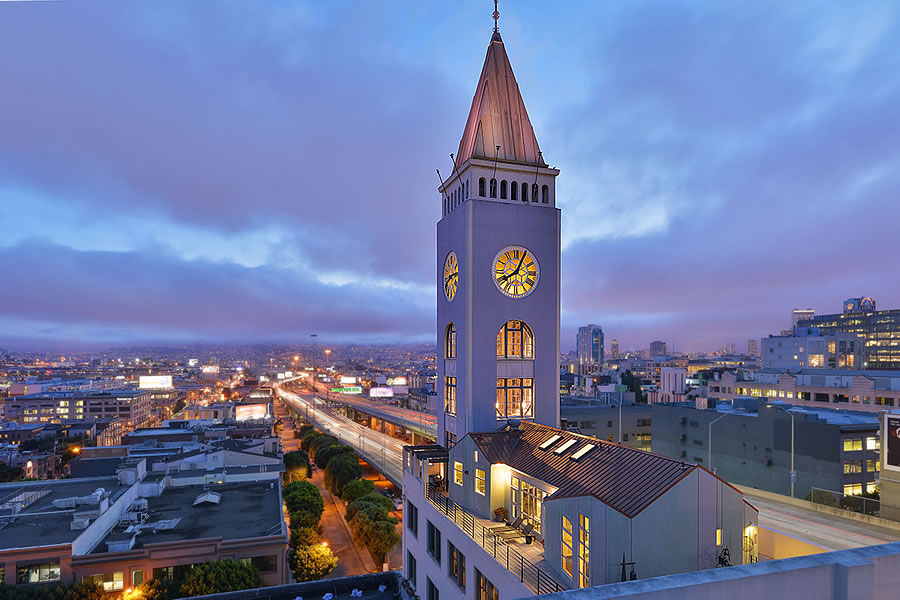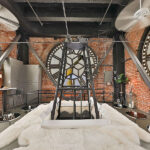The signature penthouse unit atop the historic Clock Tower Lofts Building at 461 2nd Street hit the market in the second quarter of 2016 with a bit of fanfare and an $8.5 million price tag.
Positioned as the “ultimate San Francisco trophy property,” the 3,000-square-foot unit is currently configured with two bedrooms on its main level, around which an additional 1,300 square feet of private patio space wraps, and three levels within the clock tower, including the clock room itself.
And having been reduced to $6.995 million in the third quarter of 2016, to $6.25 million in 2017, and then to $6.0 million in September of last year, the list price for the “must have” penthouse has just been further reduced to $4.995 million, or roughly 41 percent below its original list price, a sale at which would be consider to be “at asking” according all industry stats and aggregate reports.
And having gone into contract three weeks ago, the sale of the Clocktower penthouse unit has just closed escrow with a contract price of $4.85 million, which is officially “within 3 percent of asking” according to all industry stats and aggregate reports (but 43 percent below its original list).















How exactly does that work? it’s 43% below asking but still “at asking?” Is that realtor lingo?
If the seller only paid $770K in 1993…..
As previously noted, the unit has been extensively remodeled/improved since.
Great deal for the seller!
4.8 million for 2 bedrooms! Dang Gina!
Do you have to leave the lights on all night to keep the clock lit up?
More importantly, do you stay up at night and wait or set an alarm for the “spring forward” to move the clocks hands? Maybe harder for the “fall back”.
Super cool party pad, but shame the balcony is so close to the highway as to be unusable.
Brochure: “Sold in only a week!” I can sell yours too!
Ha ha, 4 years.
I wonder how much your life expectancy is reduced living on a freeway like that for 27 years.
At least they always know what time it is…..
I believe the sellers of this unit were also the buyers of the Alamo Square Painted Lady (that was recently featured here on SS).
I have been to a party in this unit. The clock part is undeniably cool, but the the overall space is very chopped up between multiple levels. Accessing the top requires climbing a ladder. The main living space feels pretty small at this price.
i get that realtors use those silly X% above asking stats, but really, what difference does it make?
the only stats that matter are the actual price it was sold for and the total number of days (all of the different agents and price reductions included). Realtors use the tricky marketing language to get leads, but buyers and sellers should use data while making a decision, not hype.
Although most real estate people see themselves as merchants in the best sense, and in San Francisco (but not London, Paris or NY) sometimes as socialites, in fact they are sales people. So they always portray things as better than they are, use a peculiar style of English (“complete this floor”), and talk up whatever is the current local fashion (white sheetrock, grey paint, SubZero refrigerators.) This must work or they would change. But some of them, privately, especially with friends, will admit that this is all salesmanship, true or not. Their goal is to get the listing and sell, which, after all, is their job. It can be a pleasant way to make money, but those who take it too seriously run the risk of being morally compromised beyond the euphemisms of general salesmanship.
I am grateful that socketsite tracks the real days on market and the reductions, giving us readers a much more honest view of the market.
Actually, for the most part they’re ‘used house salesmen’ (and women). If that carries negative connotations, then I would presume it’s due to the practices involved, rather than the actual product.
But I’m not clear on your distinction b//w “merchants” and “sales people”..the former ride in carriages, the latter in cars, or something like that?
In my mind, “merchants” make their money from the actual creation of the product; taking the amount left over after operating expenses, interest, taxes, etc. have been deducted from the total revenue brought in and paying themselves (or their LPs) out of that. In this conversation, the developer of the building is the merchant.
“Sales people” make money by getting the product sold at whatever price the market will bear. They make their money from commissions (“rips”). Real estate agents, mortgage brokers…they are sales people. Nothing to do with what kind of vehicle they travel in.
I see. I think then, i would use “artisans” to describe what you’re calling “merchants”…but no, I never equate realtors with either of those terms.